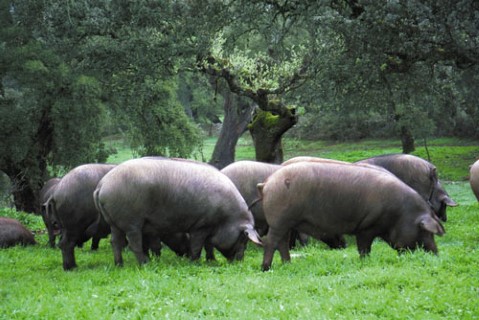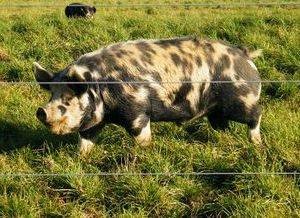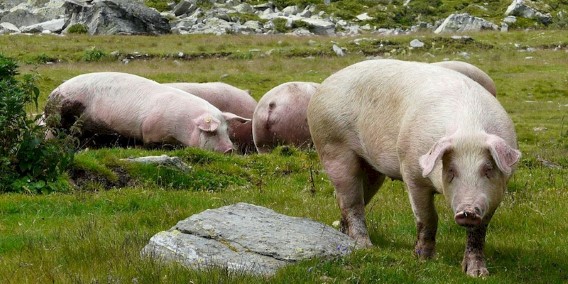 Iberian
Iberian
 Iberian Pigs are
meat pigs from to the Iberian Peninsula. The Iberian pig can probably be traced
back to the Neolithic, when animal domestication started. Currently they are
found in herds clustered in the central and southern part of Portugal and
Spain.
Iberian Pigs are
meat pigs from to the Iberian Peninsula. The Iberian pig can probably be traced
back to the Neolithic, when animal domestication started. Currently they are
found in herds clustered in the central and southern part of Portugal and
Spain.The most commonly accepted theory is that the first pigs were brought to the Iberian Peninsula by the Phoenicians from the Eastern Mediterranean coast (current day Lebanon), where they interbred with wild boars. This cross gave rise to the ancestors of what are today Iberian pigs. The Iberian breed is currently one of the few examples of a domesticated breed which has adapted to a pastoral setting where the land is particularly rich in natural resources, in this case ac ...

 Idaho Pasture
Idaho Pasture
 Idaho Pasture Pigs (also known
as IPPs) were developed from Duroc, Old Berkshire, and Kunekune pigs. They are
grazing pigs and are very gentle, have great personalities, are easy to work
with, and are smaller than traditional pig, like the Large White, while still
reaching a butcher weight of about 200 - 250 pounds in 9 - 10 months eating
primarily grass.
Idaho Pasture Pigs (also known
as IPPs) were developed from Duroc, Old Berkshire, and Kunekune pigs. They are
grazing pigs and are very gentle, have great personalities, are easy to work
with, and are smaller than traditional pig, like the Large White, while still
reaching a butcher weight of about 200 - 250 pounds in 9 - 10 months eating
primarily grass.They are a well-proportioned pig with a medium width in the leg set, a wide back, noticeable shoulders, developed hams, and a overall, nicely proportioned head with a short - medium upturned snout.Sows should mature at 250 - 300 pounds and the boars should mature at 300 - 400 pounds.

 Italian Landrace
Italian Landrace
 Italian Landrace Pigs represent a distinctive Italian variation of the Landrace pig breed. These pigs are characterized by their large size, remarkably long bodies, lop ears, and striking white coat.
Italian Landrace Pigs represent a distinctive Italian variation of the Landrace pig breed. These pigs are characterized by their large size, remarkably long bodies, lop ears, and striking white coat.
Originally imported from Denmark in the post-Second World War era, Landrace pigs were specifically chosen for their suitability in the production of Salumi and prosciutto crudo, renowned dry-cured hams traditionally thinly sliced and served uncooked in Italian cuisine.
Following the Large White Italiana, Italian Landrace pigs hold the distinction of being the second-most prevalent pig breed in Italy. Their adaptability to local farming conditions and their role in the production of prized Italian cured meats solidify their ...
